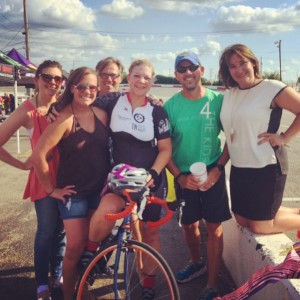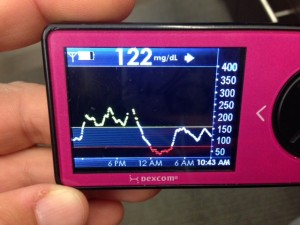Back in July, I participated in my first bike race. It was a 20-minute criterium, part of the Music City Crits held (almost) weekly during the summer at the old Nashville Fairgrounds Speedway. I worked really hard to get ready for the race, both with training on the bike and with testing blood sugar and insulin game plans.
Want to know what a crit race looks like on a continuous glucose monitor graph? Here you go:
I had great numbers all day, and I was hovering around 200 before the start of the race. I had a slight spike from adrenaline, but in training I learned hard efforts (like racing and sprinting) drop me fast. On a normal road ride, I run 100-140 and if I have a low blood sugar I can stop and fix it. In a race, I don’t have the luxury of stopping without losing time and position. You can see the adrenaline from the race (at 4:30 p.m.) lasted for a little while. I hesitated eating pre-race because of the typical adrenaline spike, but I downed a Huma gel nonetheless. Seeing as this was my first race, I wanted to run a little higher anyway. Worst case, I knew I’d be done in 20 minutes and could fix any major highs. The yellow lines showcase my blood sugars ranging between 160-220 (and that’s with a post-race bolus of insulin.)
At bedtime, I was 141. I drank a glass of orange juice knowing I would continue to trend down a bit. I was low from midnight to 4 a.m. I didn’t hear my CGM buzz or beep and slept through the entire low. (For me, sleeping through lows is common, but it’s also dangerous.) I woke up at 4 a.m. and drank a glass of orange juice before going back to bed. I woke up for the day at 137 and went about business as usual. I had great numbers the rest of the post-race day.

With T1D, life (and especially an active one) is a series of experiments. I test efforts and plans, and I adjust my insulin and food ratios based on the results. It was hard to find a plan for this race because A) I’ve never raced before so I have no base line from which to start, and B) It’s hard to recreate a race atmosphere (and simulate adrenaline) in the testing process.
Now that I have a base line, I can work on it during the off-season to be better for next year. I loved racing, (even though it was one of the toughest physical things I’ve done), and I’m going to give it a shot next year.
